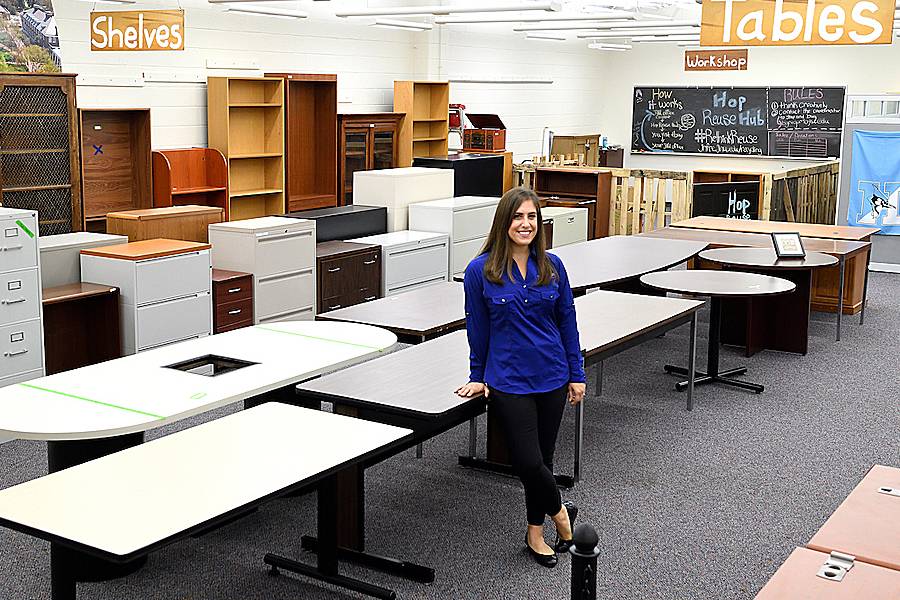It looks a lot like a thrift shop, chock-full of assorted tables, chairs, and desks, along with some stray novelties—a conductor's podium, a wheelchair, posters from the 1990s. Deep within the Keswick building, this large basement warehouse is a place where Johns Hopkins puts its "zero waste" ideals into practice.
The Hop Reuse Hub collects lightly used furniture and wares from workspaces around the greater Homewood campus, selling the items back—at slashed prices—to offices and departments at Hopkins that can make use of them. Items that need a little love can be refurbished here, and those that aren't salable get donated or recycled.
The woman in charge of this effort is Brigid Gregory, JHU's recycling coordinator in the Office of Facilities and Real Estate. After earning her MBA with a focus on sustainability, Gregory joined Hopkins in 2017 and set about revamping its furniture reuse program as one of her missions.
We sat down with Gregory to learn more about the Hop Reuse Hub, and her work to help the Hopkins community resist "the throwaway culture."
Who uses the Hop Reuse Hub?
On the supply end, we take stuff from offices, labs, classrooms, and other workspaces around the Homewood campus. These items are no longer of practical use for those places, but they're still in good condition for somebody else's needs. For example, we have right now a full table set from a boardroom in Shriver Hall.
With those who are buying, we sell to offices and departments all across Hopkins. Usually it's a one-off because a desk is busted or something, or sometimes it's a larger need, like a full set of office chairs.
Beyond that, we find items that we donate to local partners, like nonprofits and schools. [More details on those donations below.]
How does the process work?
People who work on the Homewood campus put in requests to have us remove their furniture and office ware. We can send out a truck for free pickups.
Then any department or office from anywhere at Hopkins can buy these items—you can come in here to browse by appointment [email bgregor9@jhu.edu or call 410-516-5736] or look through our online database. We use a thrift-store model—items are priced initially at 10 percent of their original cost, but if they sit here for a while, the price lowers. After three months, prices are very low.
We offer free delivery services for buyers at Homewood, Eastern, and Keswick, and with the other campuses we can help arrange deliveries.
What type of items are salable, and how much do you sell?
First, we look at the condition of an item. If it's in great shape, it comes here, no matter what. It could be a full office set or just a solo chair. The other thing is, I keep an ear out for what staffers are looking for. Last fall, it was tables—everybody needed a side table. And there's a certain look that Hopkins has, so I can gauge what types of items will go back on campus easily.
In the last academic year, we sold nearly 200 pieces, a total of over $11,435. That money goes into the budget of the Homewood Recycling Department and helps cover some of the hub's costs.
What happens to the stuff that isn't sold?
Any item that won't sell but is still perfectly usable becomes a donation. A lot of stuff fits this category. I reach out to our donation partners—we work with lots of local nonprofits, like CivicWorks—or they reach out to me. Last year, we donated over 200 items to about 10 nonprofits.
We also work with places like clinics and schools. Last year, for example, the Bloomberg Center for Physics and Astronomy was redoing a lab and got rid of about 50 metal stools—we found a Baltimore City public school that needed them.
But any item that's beyond reuse goes to recycling. Hopkins has an open-top dumpster next to the power plant at Whitehead Hall, so items that can be broken down for recycling head there, and a third party salvages the usable parts. Wood and metal are the two materials they're typically looking for.
What background do you bring to this job?
Before Hopkins, I finished up my MBA at University of Delaware. I knew I wanted to work an operations-focused job but centered on sustainability. Before that I worked in sustainability at a couple other universities, and my bachelor's was in energy, business, and finance from Penn State.
What was the reuse program like when you first arrived, and how did you improve it?
The Furniture Reuse Program started in 2013 as a way to recirculate the huge stock of furniture left behind in the Keswick offices when Hopkins took over the building from an insurance company in 2010. Then it expanded to take in items from Homewood.
When I came in last year, I was tasked with taking that program to the next level. I really wanted to do some creative things to encourage people to think differently about reuse. I created this plan for the Hop Reuse Hub to take it from basically a rather messy warehouse where furniture was stacked everywhere to having a totally organized inventory system so we can track exactly what's here and what's going out through an online database.
We hired a student assistant, Roderick Bowlby, who has been instrumental in creating this space here now and took charge of our new offering for refurbishments.
Tell us about those refurbishing services.
I noticed we were getting all sorts of furniture that just needed a little love—a little retweaking or repair. So Roderick and I bought some supplies—wood fillers, furniture polish, staple guns, fabric cleaner—and now we can fix up items that come in with dents or dings, or just need a little cleanup.
For larger jobs, we have a partnership I started with Re-form, a furniture refurbishment company in Baltimore. We can send them big collections of old furniture, and they make everything look brand-new.
What are some memorable items that have come through the hub?
We get some stuff that could be classified as antiques. Occasionally, the Homewood Museum will do some cleaning out, and the Bloomberg Center has given us some really old antique display cases.
There's a lot of pieces that have some history. We have some furniture from previous JHU presidents. We even have an old conductor's podium from Shriver Hall.
And what's the story with the artwork on the walls?
I started telling custodians and our student workers to watch out for stuff going into trash that looked unique or quirky. So I've collected all these oddball things that are really interesting and liven up the space. We have posters that were hanging up in offices, displays and awards from former events, stuff like tapestries, even some old photos. I have one photo of a group of golfers from who knows when at the Columbus Golf Classic. Someone once came in and told me, "I was at that golf outing."
You also work on reuse events. What's coming up?
We're working in partnership with the Station North Tool Library, which hosts a well-established Fix It Fair with repair experts across many categories. Their next fair is Oct. 20, and we're helping promote the event and providing Blue Jay shuttle transportation for Hopkins students and staff who register.
We're also hosting a Lunch & Learn event on Oct. 30 in Homewood's Glass Pavilion, where we're going to focus specifically on bike repairs. People can learn how to do tuneups, keep their bikes in good shape, and enjoy a free lunch!
Posted in News+Info
Tagged who does that?









